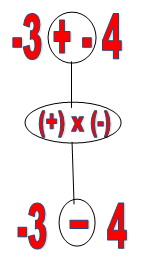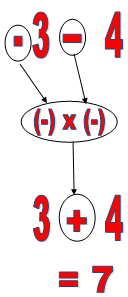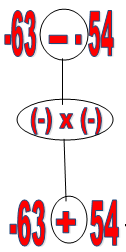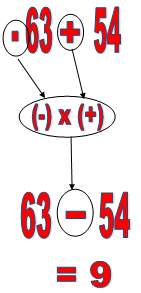| Home » Articles » LESSON NOTES (Mathematics) » Upper Primary |
BASIC OPERATION ON INTEGERS How to add and subtract integers: As you know the following: (+) x (+) = (+) (-) x (-) = (+) (+) x (-) = (-) (-) x (+) = (-) In short, multiplying same signs gives (+) and multiplying different signs gives (-) The knowledge above will be used in operation on integers.
ADDITION AND SUBTRACTION OF INTEGERS Note that, there are so many methods you would learn in your life but I decided to teach you this simple method, so don’t reject other methods when you are given so long as they direct you to the correct answer.
EXAMPLE #1 (-3) + (-4) = Solution Step 1: Take all signs in the middle of your question which are found after the first number and before the second number, then multiply them in order to get only one operation. As shown below:
In this case we have (+) after-3 and (-) before number 4 so take (+) x (-) and get (-) as shown in the picture above:
So the question will be: (-3) – (4). Don’t write the second number with the sign because you have already combined it with the operation in the multiplication of the signs in step number one above.
Step 2: we have 2 and 4 in step number 1 above, so what operation will be applied?
Multiply again the available signs will determine the operation: We have all (-), so multiply (-) x (-) = (+) as shown in the picture below:
This tells us that we have to add the numbers so add them: 3 + 4 =7 We got 7, is it Positive(+) or Negative (-)?
The sign of the answer is taken from step 1 after combining the middle sign, check the sign of the larger digit. From our question, step number one gave us -3 – 4, the larger digit is 4 and 4 is negative (-). So the answer is -7
Therefore: (-3) + (-4) = -7.
EXAMPLE #2 (-63) - (-54) = Solution Step 1: Take all signs in the middle of your question which are found after the first number and before the second number, then multiply them in order to get only one operation. As shown below:
In this case we have (-) after-63 and (-) before number 54 so take (-) x (-) and get (+) as shown in the picture above:
So the question will be: (-63) + (54). Don’t write the second number with the sign because you have already combined it with the operation in the multiplication of the signs in step number one above.
Step 2: We have 63 and 54 in step number 1 above, so what operation will be applied?
Multiply again the available signs will determine the operation: We have (-) AND (+), so multiply (-) x (+) = (-) as shown in the picture below:
This tells us that we have to find the difference between the numbers so subtract: 63 + 54 =9 We got 9, is it Positive(+) or Negative (-)?
The sign of the answer is taken from step 1 after combining the middle sign, check the sign of the larger number. From our question, step number one gave us -63 + 54, the larger number is 63 and it is negative (-). So the answer is -9
Therefore: -63 – (-54) = -9.
Try yourself:
1. (-21) – (+42) = 2. (544) – (-90) = 3. (-310) + (+43) = 4. (+22) – (33) = 5. (-876) + (433) = 6. (-110) – (-332) = 7. (-65 + 32) – (-54) = 8. -88 + (90 – (-44) = 9. 700 – (+336) = 10. -98 – (-98) =
*************** All the best ******************
| |
| Views: 626 | | |
| Total comments: 0 | |



